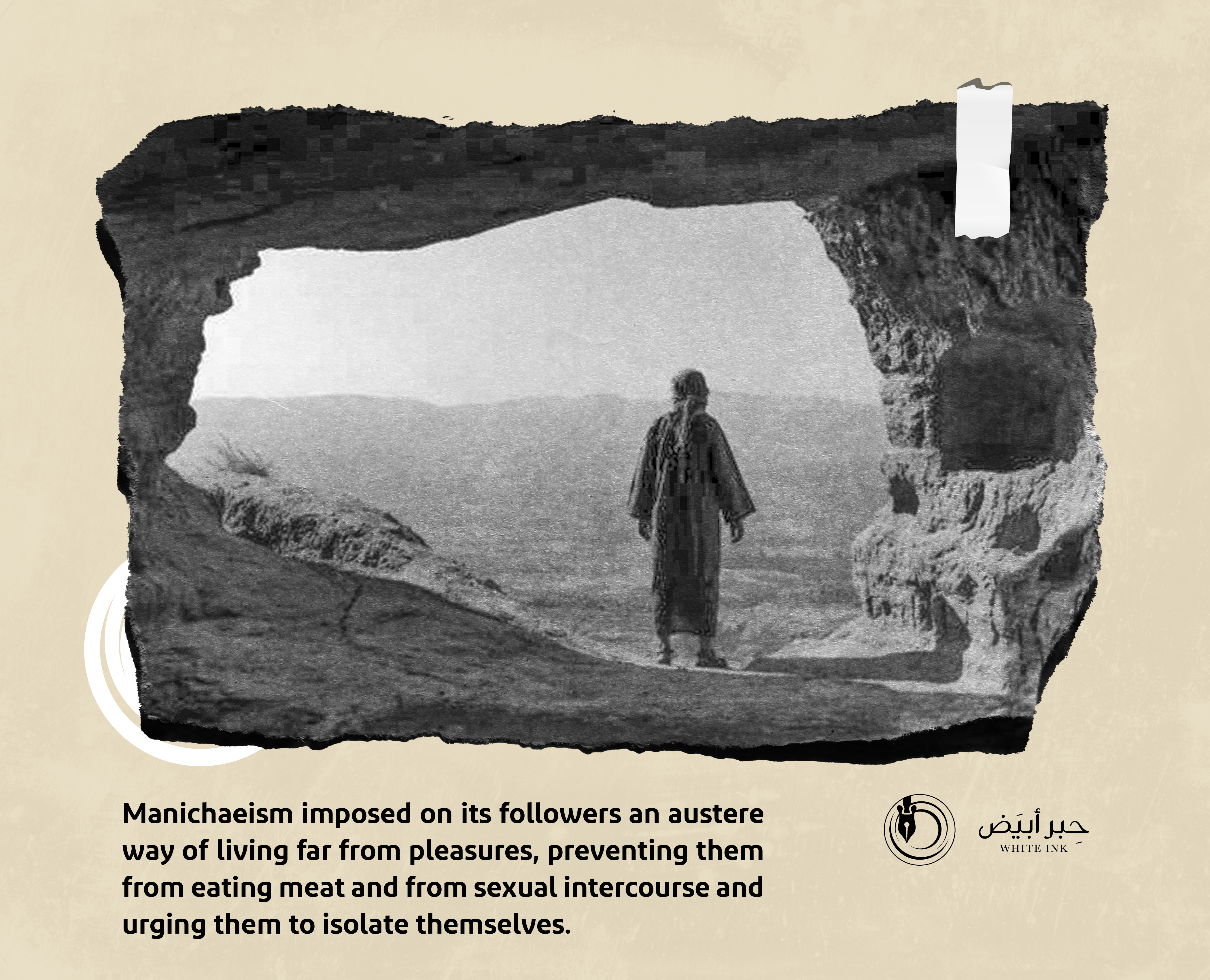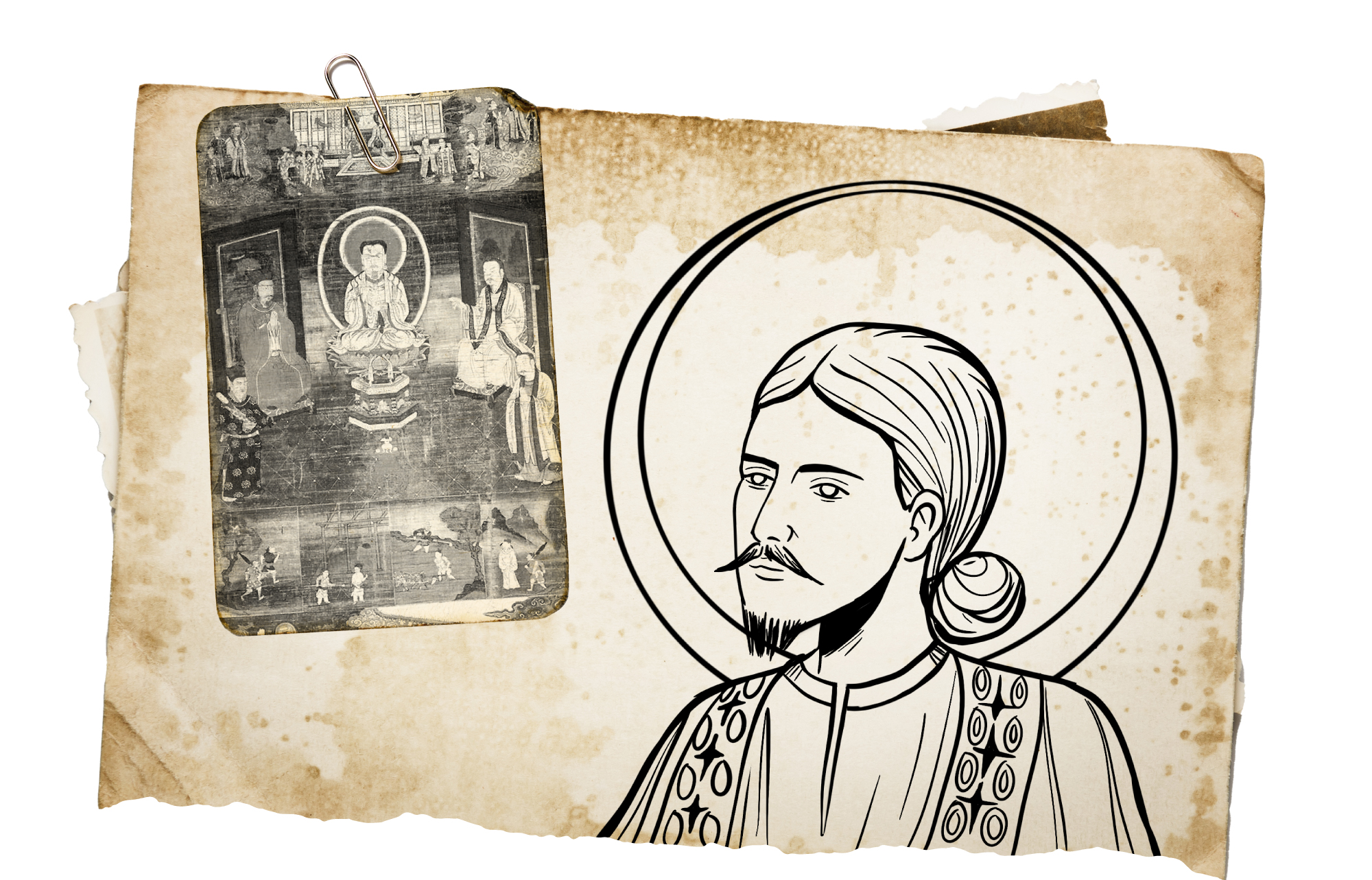
It remained a matter of separated rituals and beliefs,
Manichaeism...Another form of distorted Persian belief
Manichaeism or Mananism is one of the marginal religions that emerged in Persia in the second half of the third century AD, at the hands of its founder Mani, who was nicknamed the Messenger of Light or the Supreme Pulpit. Historians didn’t agree in their documentation of this religion, as some considered it a religious belief in its own right, and some others described it as pure Christian heresy, but most of them considered it an influence of the Christian faith.
It was influenced by Christianity on many levels, and it was a Persian hybrid of several cultures.

Although some of them went to the extent of denying the existence of this religion, and claimed that its founder was a man-made fictional figure by its followers, many historians confirm that Mani is a real person born in the year (216 AD) in a rural area north of Babylon.
Some historical writings narrate about his personality that his father, named Fatq, lived around the year (200 AD) in the city of Hamedan, and was married to a woman named Maryam. One day, a person called out to him from the temple of the idols house, saying: “Oh, Fatq, you shall not eat meat, nor drink wine, nor marry people.” When Fatq heard him, he caught up with people who were in the areas of Dostiman who were known as the “bathers”, and Mary became pregnant with a kid named Mani shortly after the incident in the idols house.
This difference over whether Mani existed or not was not resolved historically, but the teachings and principles of Manichaeism are full of myths, superstitions and tales that had forced concepts, such as those related to the story of the creation of Adam and Eve. According to the Manichean conception, Satan “Ashkelon” swallowed all of the frightening male animals, and the frightening female animals were given as a sacrifice to Namarael, “The Demon”, and after this Ashkelon and Namarael gave birth to Adam and Eve, the first human creatures.
The Manichaeans adhered to strict doctrinal discipline, and their faith was strict in matters of prohibition and forbidding, as their followers abstained from having sex, and they followed a harsh diet, most notably abstaining from eating meat and drinking alcohol. The Manichaeans adopted their basic vision from a radical dualism of Iranian origin.
The details that were mentioned in the books of historians are different to the point of contradiction, and the reason for this is due to the absence of original manuscripts or recurrent scriptures, which prompted some people to fill the historical gap by resorting to imaginary writing or linking and combining writings from an ancestor, which resulted in a complex religion in terms of principles, and of which beliefs are distorted and difficult to study and understand.
In this context, Ibn al-Nadim lists the conditions for converting to Manichaeism, saying: “The one who wants to convert to the religion should test himself, and if he deems himself able to suppress lust and greed, abstain from eating meat, drinking wine, intercourse, and to not harm others with water, fire, and magic, and to never commit hypocrisy, then he is allowed to convert to the religion, otherwise he may not convert”
The teachings of Manichaeism raised a lot of confusion about the similarity of some of its concepts with Christianity, and some of them went even further when they claimed that some of the teachings of Islam are nothing but Manichaean teachings, which was responded to by Muslim scholars who refuted this random, non-objective claim with little effort and precise origin study.
As for Manichaean legislation and ordinances; Mani obligated his followers to perform ten ordinances, in addition to three final ones, and to fast seven days every month. As for the ordinances, they are to believe in the four greats, God and his light, strength and wisdom. God is the King of the Heavens of Light, his light is the sun and the moon, his strength is his five properties, and his wisdom is his sacred religion. As for the other ordinances, they are to abstain from the worship of idols, lying, miserliness, murder, adultery, theft, teaching magic, and to perform one’s religion, relax and work in a calm manner, and to perform four or seven prayers.
Manichaeism claims to have focused on the transcendence of the human soul, and prompted it to refrain from doing anything that could obscure the light in its eternal struggle with darkness. The Manichaean teaching was strict in abstaining from anything that might strengthen the sensual lusts of the body, and since meat was the food of demons, and eating it was a bodily lust, it was an obligatory duty to avoid eating meat, and for this reason the Manichaeans prepared themselves to live on eating fruits, and they also preferred to eat oil.
As for dealing with nature partners such as plants and animals, the Manichaeans were not allowed to uproot any plant or kill any animal, and finally they were required to abstain from sexual intercourse altogether, including abstaining from marriage. Not to mention that it is impossible to link such teachings to a divine revelation, the mere prohibition of marriage is sufficient to say that the extinction of its followers is more likely, which confirms that the Manichaean religion remains a matter of general non-realistic principles that were promoted in a time period, which left behind a number of rituals attributed to those who claimed to be the prophets of God.


- Jeuwaid Negrin, Mani and Manichaeism: A Study of the Heretical Religion and the Life of its Founder (Damascus: Dar Hassan, 1985).
- Hussein Atwan, Heresy and Populism in the First Abbasid Era (Beirut: Dar Al-Jeel, d.).
- Firas Al-Sawah, Encyclopedia of the History of Religions: Zoroastrianism, Manichaeism, Judaism, Christianity, 4th Edition (Damascus, Dar Al-Takween, 2017).
- Ibn Al-Nadim, Al-Fihrist (Beirut: Dar El-Maarifa, d.).
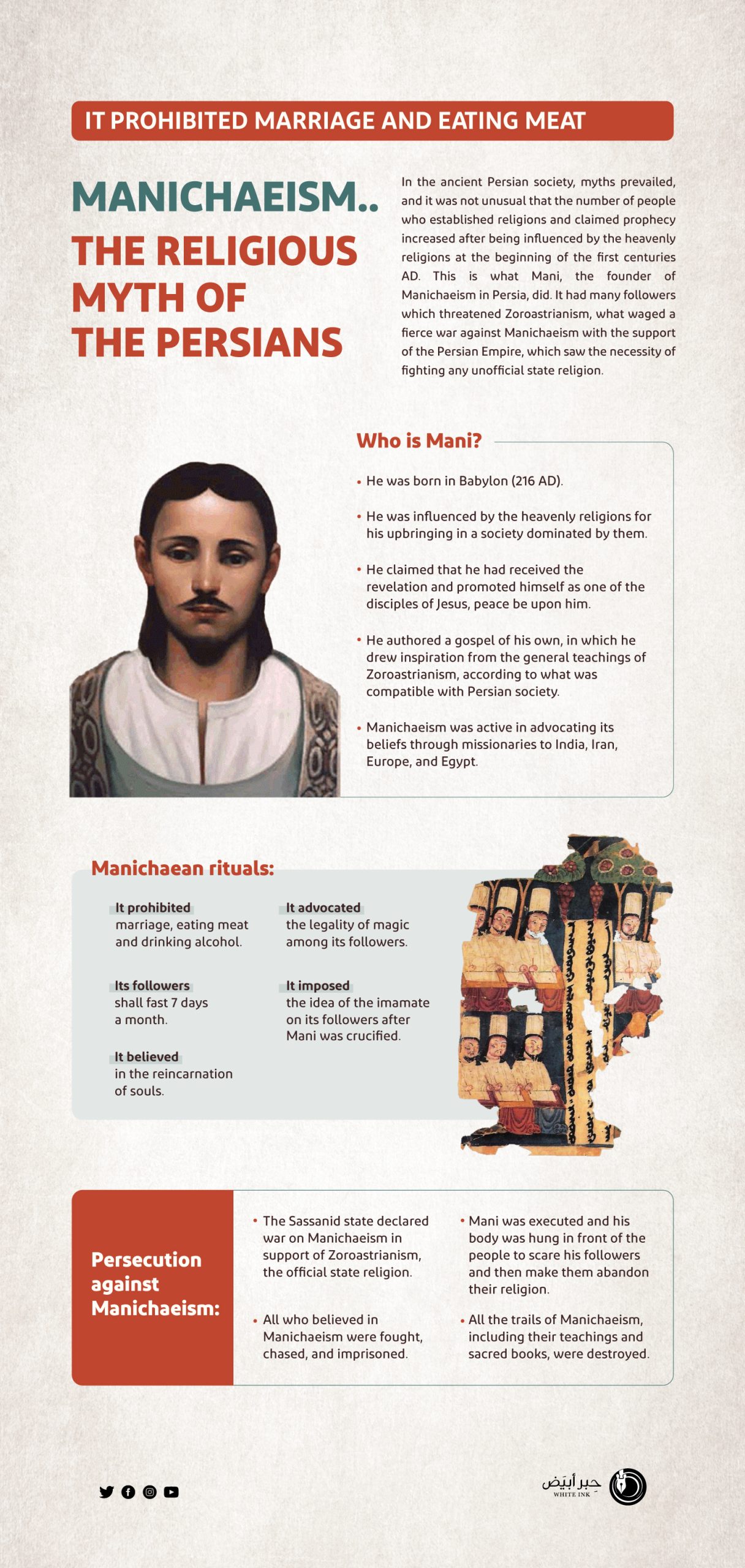
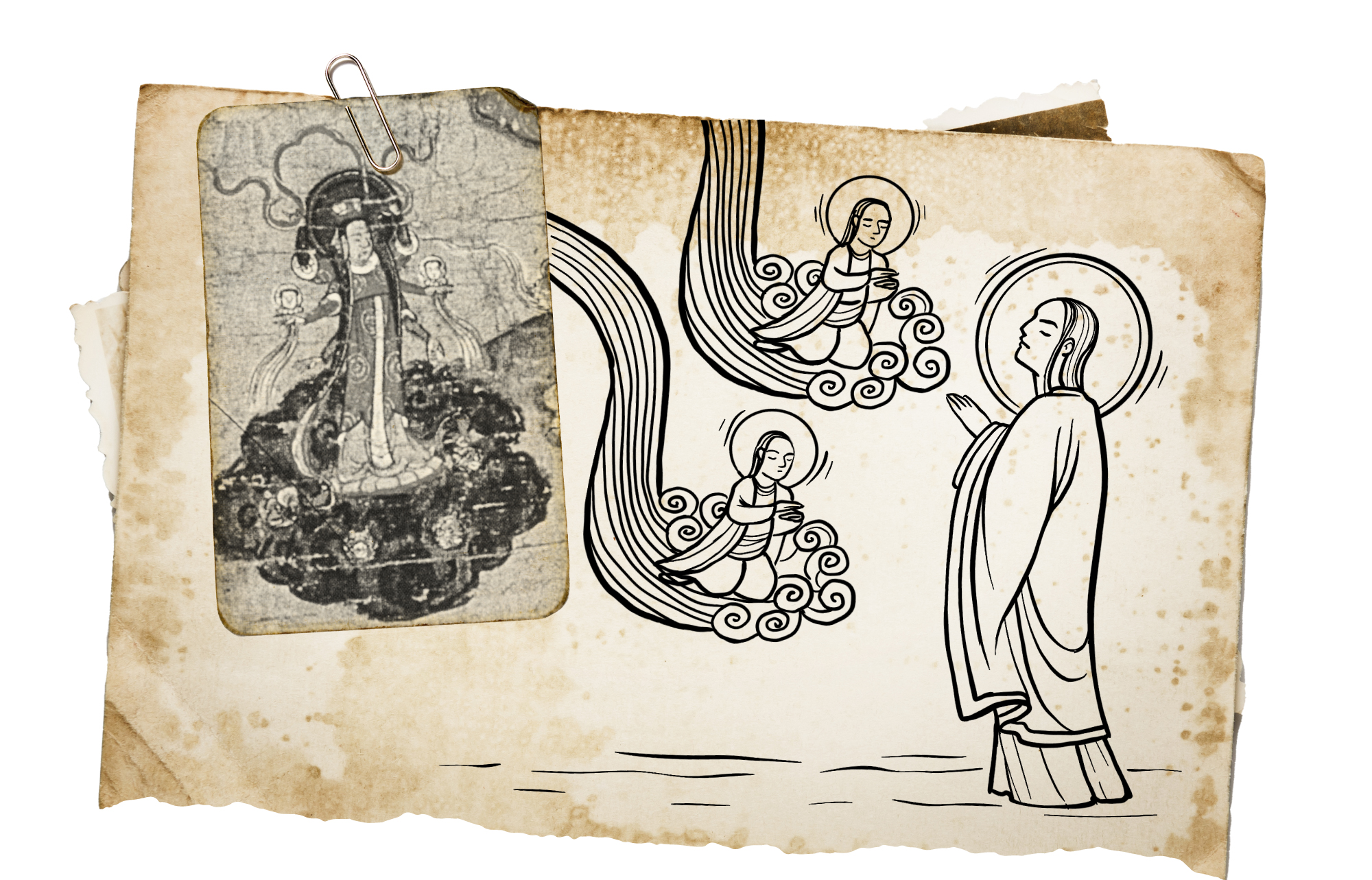
It had its own Gospel,
The "Imāmiyya" started with the Persian belief after killing the founder of Manichaeism in the second century AD
The Persians believe that the Manichaean belief is the second basis for their ancient beliefs that they cherish after Zoroastrianism, and which are still to this day influencing their rituals and beliefs in their culture. Manichaeism, in its simplest definition, is: a dual religious movement that worships and follows both light and darkness. It emerged during the third century AD in Persia, and was considered a religion in its own right, despite its imitation of Christianity and Judaism.
Manichaeism has been referred to in various Greek, Coptic and Persian scriptures, which documented its historical period. Manichaeism, as it was greatly influenced by the Christian religion, is considered by some to be an abstract heresy derived from a theistic religion, so it is difficult to consider it an independent religion from other religions. However, its doctrinal and historical connection to the Persians, and their belief in it, whether as a belief, ritual, or culture; makes it independent with different religious aspects, even if it is based on the legacy of the theistic religions.
According to what Hussein Iyad describes in his book The Doctrinal Ideology of the Manichaean Religion: “Manichaeism is one of the religions that emerged in the third century AD, and had a great influence on the beliefs and minds of people at the time, and the beliefs and concepts of this religion are still known among many residents of Southeast Asia and Iran, knowing that it began in the land of Mesopotamia and in the city of Babylon in particular, due to the status of this city and its civilized development”.
The founder of Manichaeism had his own style, in which he collected many concepts and perceptions that he borrowed from the theistic religions, as well as from non-theistic ones, and mixed them together. He then organized his own constitution for his followers and imitators to organize and conduct social life in accordance with Persian culture, and this may be the quotation that Mani worked on; one of the things that negatively affected the spread of his faith in his time, especially that most of his followers were Persians, while other nations did not look at him more than as an imitator of others.
The importance of studying Manichaeism emerges from its intellectual sources from which it drew its ideological ideas and the constitution of its work, the most prominent of which were Christianity, Zoroastrianism and Buddhism, in addition to other intellectual movements. Therefore, from the historical side, it was a study of the life of its first founder and his origins, as well as the religious beliefs and concepts and the prophets who influenced his personality, which prompted him to adopt these ideas and quote them directly and indirectly, that had a clear impact on his beliefs and concepts, as well as his theories about creation, teachings, and worship followed by his imitators and followers, as well as his most important writings and letters.
As for his reason for quoting and imitating the theistic religions; It is due to the fact that Mani was born in Babylon and raised in a mixed Jewish-Christian environment, and spent the beginning of his youth in Mesopotamia. At the age of twenty he began to spread his new religion in an attempt to create a universal religion acceptable by all people, not limited by a mystical education based on indoctrination. At the age of eleven, he began developing some new ideas in his mind, opposing many of the religious beliefs in his community, such as the Quartet Gospels and Paul’s letters.
As soon as he became twenty-four years old, he claimed that a revelation had come down to him instructing him with divine teachings, which formed the basis of the Manichaean religion and deemed himself the Holy Spirit and the mediator preached by the Prophet Jesus, and presented himself as a new prophet during the inauguration ceremony of the Sassanid King Shapur I, deeming himself part of the chain of prophets and the heir of Zoroaster in Persia, Buddha in India and China, and Jesus Christ in the West, and that he is a universal prophet of all people and the last of the prophets.
Thus, Mani aimed to try to merge other religions by establishing a link between his religion and other Christian, Buddhist and Zoroastrian religions. Therefore, Mani considers Buddha, Zoroaster, and Jesus as his ancestors. He wrote several books, including his Gospel, which he wanted to be a perfect copy to the Gospel of Jesus, son of Mary, peace be upon him. There is a similarity in the narration of the killing of Mani with the narration promoted by the Christians claiming the killing of the son of Mary, peace be upon him.
Mani also promoted himself as one of the disciples of the Prophet Jesus peace be upon him, but the Christian Church rejected such claim, and considered him a heretic and his religion as some sort of heresy. Despite that, Manicheans obtained the support of a number of high-ranking political figures in the Persian Empire, in which they found a national belief appealing to its people, so Mani began to send missionary messages that reached Turkestan, India and Iran to spread Manichaeism in various parts of the ancient world very quickly, until it reached Rome in (280 AD), and Manichaean houses of worship emerged in it in (312 AD) during the reign of Pope Miltiades, while it arrived in Egypt in (244 AD) and became known to the people of southern France in the year (352 AD).
One of the most prominent beliefs of Manichaeism is reincarnation, which is a concept as old as heresies. It tries to deny the resurrection in some religions, so those who can’t accept the truth resort to such concept because it gives them ready solutions to the idea of resurrection, and Manichaeism is not far from such goal. The book “Non-Theistic Religions and Their Sacred Sources from an Islamic Point of View”, says the following on reincarnation as part of the main concepts in the Manichaean religion:
The heresy of reincarnation emerged in the imaginations of some philosophers who said that the world is old, and that resurrection is impossible after death, and they supported the idea of reincarnation of souls into different bodies of various forms, such as the reincarnation of the human soul to an animal or the soul of an animal to a human being, as they claimed that whoever commits a sin will be punished for that sin in another form, and the same applies to rewards. The Manicheans also supported another idea of reincarnation, relying on the teachings of Mani, who believes that the souls that depart from bodies are of two types: the souls of the righteous, and the souls of the misguided. As for the souls of the righteous, if they leave their bodies, they raise from the daylight column to the superior light that is above the universe, and remains in that world with continuous pleasure. As for the souls of the misguided. if they leave their bodies and want to catch up to the superior light, they will settle in other bodies.”
There is a great similarity between the story of the Christians and their claim of the crucifixion of Christ, and the story of Mani’s followers who died at the hands of the Persian religious establishment in prison before being killed and crucified based on the ruling issued by the Persian Emperor Bahram I. However, Mani’s death in (277 AD) had a positive effect on increasing the spread of Manichaeism even further, which increased the persecution and repression of his followers at the hands of Emperor Bahram II, where he killed the missionary Seys and pursued the Manichaeans wherever they were, and Emperor Diocletian followed his campaign in the year 302 AD when he issued a decree ordering the subjugation of the Manichaeans by force, and massacres were committed against them in various countries during the reign of Theodosius I, who ordered the killing of all the Manichaean clergy in 382 AD.
The followers of Manichaeism claim that Mani rose to the Heavens of Light, but before his rise he appointed an imam after him on his behalf as it is common in the culture of the Persians today. The imam used to perform rituals until he died, and the imams used to practice the teachings of the religion one by one, and there was no difference in practices, and they remained on this accord until a group emerged from them known as the “Dinaburi” and they challenged their imam, and refused to obey him. It was known among them that an imam shall not be appointed except in “Babylon”, and any other imam is considered a false one.
In conclusion, it is noted how the idea of the Imāmiyya and its spreading through was only a mere Persian culture inherited from Islam since the third century AD after the emergence of Manichaeism.
The Manichaeans claimed that Mani left someone on his behalf before ascending to Heaven, and his successor must be a Babylonian.



- Hussein Iyad Muhammad, The Doctrinal Belief of the Manichaean Religion: A Study of its Origins and Influence by Zoroastrian Beliefs and Christianity (Baghdad: Babylon University, 2015).
- Hussein Atwan, Heresy and Populism in the First Abbasid Era (Beirut: Dar Al-Jeel, d.).
- Jeuwaid Negrin, Mani and Manichaeism: A Study of the Heretical Religion and the Life of its Founder (Damascus: Dar Hassan, 1985).
- Firas Al-Sawah, Encyclopedia of the History of Religions: Zoroastrianism, Manichaeism, Judaism, Christianity, 4th Edition (Damascus, Dar Al-Takween, 2017).
- Wael Suleiman, The History of Manichaeism (Aragic Platform, 2019).
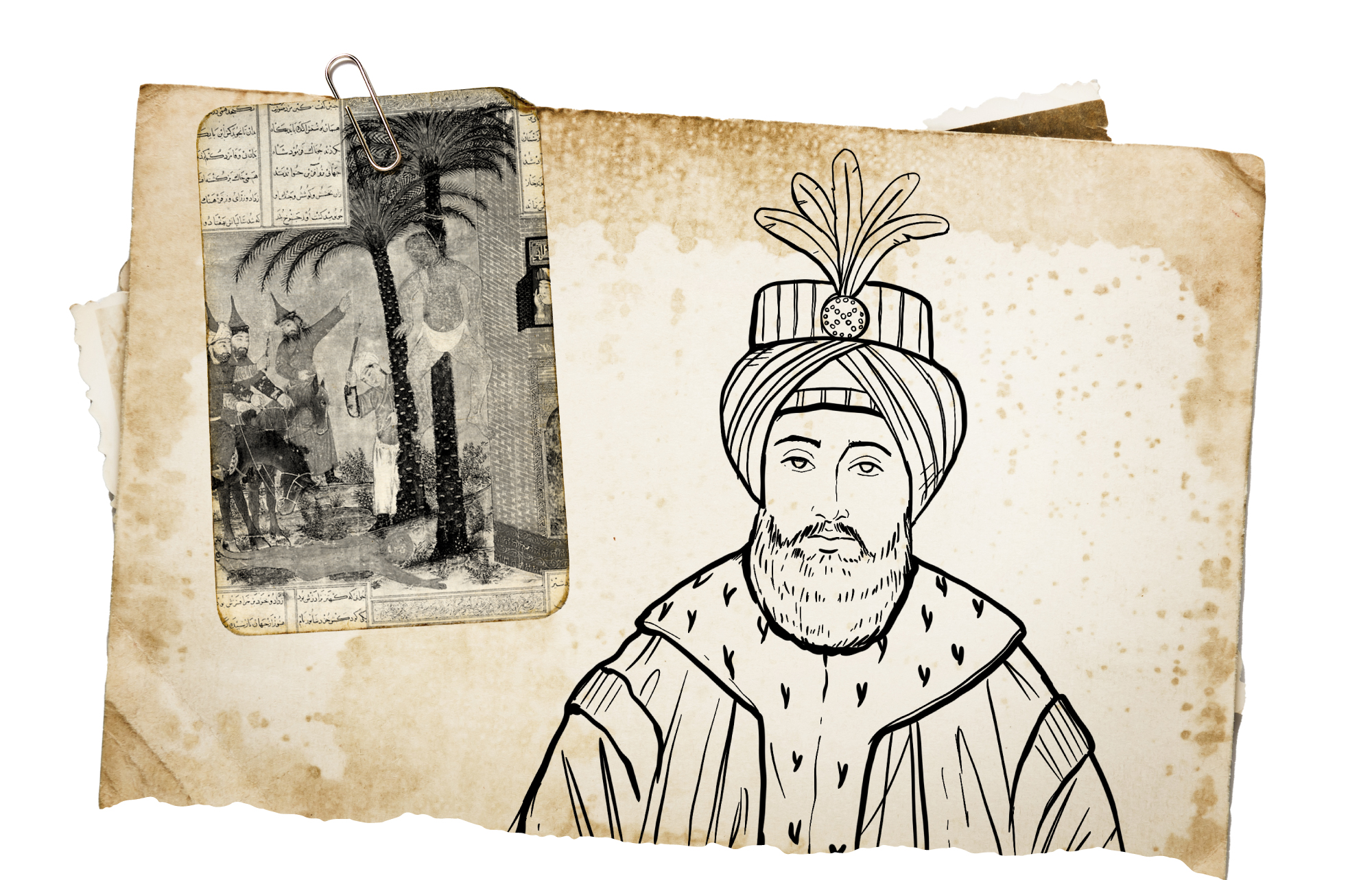
They executed Mani and chased after his supporters everywhere
The Sassanids persecuted Manichaeism in defense of the religion of their Zoroastrian empire
There are exciting and epic stories in the history of ancient Persian religions, most notably the story of the conflict between Zoroastrianism and Manichaeism, although the Manichaean religious mission in Persia started during the reign of King Shapur I. These religions divided the universe into two worlds, the world of good and the world of evil, the world of their perception of God and the world of their perception of Satan.
Mani looks at man with a philosophical look, as he sees the mixture of good and evil in him. Mankind possesses both good and evil mind. Thus, according to Mani, the world and man are based on the idea of contradiction, the contradiction that is represented by the duality of light and darkness, as neither of them will end, nor will one be connected to the other, and that they have always existed and will always remain.
Although Mani looked into the previous heavenly religions, he took a stand in which he rejected the Torah completely, and on the contrary, Mani accepted the Gospel, and even deemed himself as the last of Jesus’ disciples. He wrote his main book in the Pahlavi language, while he wrote his other books in the Syriac language. It is said he had devised a type of script borrowed from Aramaic.
The spread of Manichaeism first began in Babylon, and reached Syria, Palestine, and the ancient Nabateans, and also reached Egypt and to North Africa. In the era of the Sassanid state in Persia, an important and dangerous shift occurred in the Persian state’s view of religions. This was done by King Ardashir, founder of the Sassanid state; As he saw that the state and religion are twins, and one does not exist without the other, so the Sassanid state abandoned the issue of freedom of religion, and the Iranian historian Hassan Pernia describes this new situation, saying: “The Sassanids adopted the religion of Zoroaster as the official religion of Persia, and it did not have an official religion until that time.” The peoples of Persia were free to convert to a religion acceptable by every people, or even every individual.”
And here specifically, Zoroastrianism turned into the official religious system of the state, and thus began the persecution of the followers of other religions, especially Manichaeism. The highest form of persecution was the arrest of Mani himself by order of King Bahram I and to torture him alive; He was flayed alive, and when he died in the year (277 AD) his body was hung on two arrows in the city of Jundishapur, and this horrific sight continued to be shown to the people, in order to terrorize the Manichaeans and urge them to leave Manichaeism and convert to Zoroastrianism, the official religion of the Persian state.
The Sassanid King Bahram I flayed Mane alive and made him a horrific example for the people of his time and his followers in the year (277 AD).

Although Mani was killed, and the Sassanid state persecuted his followers, this persecution led to the opposite of what the kings of Persia desired, as Mani turned into a martyr, and his followers adhered firmly to his beliefs. The kings of Persia could not eradicate the Manichaeans.
The hostility of Zoroastrianism to Manichaeism continued even after Islam and the fall of the Persian state; Abd al-Wahhab Azzam tells us about one of the important Zoroastrian books that dates back to the third century AH, which is the book “Shakand Kamanik Fajjar”, which translates into “The Indisputable Fact.” This book is a defense of Zoroastrian dualism, mainly against the beliefs of Manichaeism, but also against Judaism, Christianity and Islam.


- Hassan Pernia, The Ancient History of Iran from the Beginning to the End of the Sassanid Era, translated by: Muhammad Nour Abdel Moneim (Cairo: The National Project for Translation, d.).
- Hussein Iyad Muhammad, The Doctrinal Thought of the Manichaean Religion: A Study of its Origins and Its Influence by Zoroastrian Beliefs and Christianity (Baghdad: Babylon University, 2015).
- Hussein Atwan, Heresy and Populism in the First Abbasid Era (Beirut: Dar Al-Jeel, d.).
- Jeuwaid Negrin, Mani and Manichaeism: A Study of the Heretical Religion and the Life of its Founder (Damascus: Dar Hassan, 1985).
- Firas Al-Sawah, Encyclopedia of the History of Religions: Zoroastrianism, Manichaeism, Judaism, Christianity, 4th Edition (Damascus, Dar Al-Takween, 2017).
- Abdel-Wahhab Azzam, Relations between Arabs and Persians and Their Literature (Cairo: Hendawy Foundation, d.).


